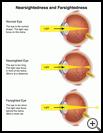
Common Vision Problems
________________________________________________________________________
KEY POINTS
- The most common vision problems include nearsightedness, farsightedness, the loss of close-up vision, and astigmatism.
- These vision problems may be helped with glasses, contacts, or eye surgery.
- Have your eyes checked regularly and see your eye care provider if you are concerned about your vision.
________________________________________________________________________
What are the most common vision problems?
The most common vision problems involve problems with the shape of your eye or lens of your eye. The shape of your eye affects how light is focused on the back of your eye, which changes how well you see.
The most common problems include:
- Nearsightedness
- Farsightedness
- The loss of close-up vision
- Astigmatism, or blurred vision
What is nearsightedness?
Nearsightedness means that you see close objects clearly, but distant objects are blurry. This happens when the eyeball is too long or when the outer layer of the eye, called the cornea, is too curved. This causes light rays to focus at a point in front of the light-sensitive tissue at the back of the eye, called the retina, instead of directly on it.
A sign of nearsightedness may be squinting to see road signs clearly. A nearsighted child may not be able to read the chalkboard at school or to watch TV without sitting very close. Nearsightedness may be helped with glasses, contacts, or eye surgery.
What is farsightedness?
Farsightedness is when you see distant objects clearly, but close objects are blurry. This happens when the shape of your eyeball causes light rays to focus in the wrong place at the back of your eye.
Some signs of farsightedness include blurry vision when looking at objects up close. You may also notice eyestrain, fatigue, aching or burning eyes, and headaches after doing close work such as reading or needlework. Often babies are born with a slight farsightedness that clears up as they grow. School-age children with farsightedness may not be interested in reading or may have trouble concentrating because they cannot keep close objects in focus. Farsightedness may be helped with glasses, contacts, or refractive surgery.
What is presbyopia?
Presbyopia is the loss of clear close-up vision that happens naturally as people get older. The lens of your eye is located behind the iris (the colored part of the eye). When you are young, the lens in your eye is soft and changes its shape easily. This lets you focus on things that are close and also on things that are far away. Around the age of 40, the lens starts to get stiff. Because the lens can’t change shape easily, you start to have trouble with your close-up vision. You may need to hold things farther away from your eyes to see them clearly. You may also have eye fatigue and headaches when doing close work. Contacts are sometimes used for presbyopia. However, it may be easier for people who already wear contacts to get reading glasses that magnify close-up objects.
What is astigmatism?
Astigmatism is blurred vision caused by an uneven curve in your cornea. The cornea is the clear outer layer on the front of the eye. As a result of astigmatism, your vision is somewhat blurry all the time.
Mild astigmatism may cause headaches, eyestrain, fatigue, or blurry vision. Severe astigmatism is corrected with glasses or contacts. Astigmatism may also be treated with surgery.
When should I see my eye care provider?
Have your eyes checked regularly even if you do not have eye symptoms. Here is a suggested schedule:
- Children ages 1 to 18: every 2 to 4 years
- At least once during your 20s, and twice during your 30s
- Ages 40 to 64: every 2 to 4 years
- Age 65 or older: every 1 to 2 years
You may need to see your eye care provider more often if you have certain eye problems or if you are at risk for problems such as glaucoma or diabetes.
See your eye care provider if you are concerned about your vision.

